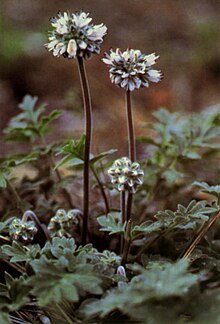
Hydrophyllum virginianum, commonly called Virginia waterleaf or eastern waterleaf, is a species of plant in the borage family (Boraginaceae). It is an herbaceous perennial plant native to Eastern North America where it is primarily found in the Midwest, Northeast, and Appalachian regions.

Cirsium occidentale, with the common name cobweb thistle or cobwebby thistle, is a North American species of thistle in the family Asteraceae.
Andersonglossum occidentale is a species of flowering plant in the borage family known by the common name western hound's tongue.

Hesperochiron is a small genus of plants in the waterleaf family containing two species native to western North America. These are thick-rooted perennial herbs growing in squat patches at ground level and producing bluish-white flowers with yellow throats. They grow in wet areas such as seepy meadows.
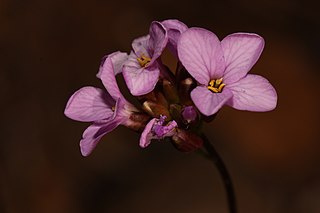
Arabis aculeolata is a species of flowering plant in the mustard family known by the common name Waldo rockcress.
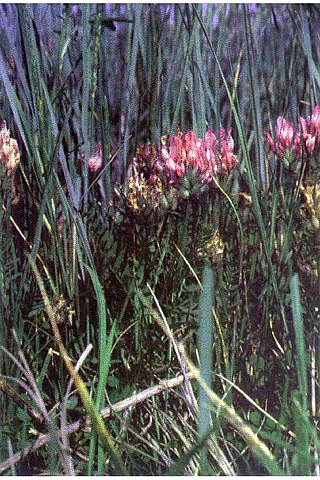
Astragalus agrestis is a species of milkvetch known by the common names purple milkvetch, purple loco, and field milkvetch. It is native to much of western and northern North America from most of Canada to the southwestern United States, as well as eastern Asia. It grows in vernally moist areas such as meadows, and is often found in sagebrush.

Astragalus albens is a species of milkvetch known by the common names Cushenbury milkvetch and silvery-white milkvetch.

Astragalus layneae is a species of milkvetch known by the common name widow's milkvetch. It is native to the Mojave Desert and surrounding mountain ridges in California and Nevada.

Carex concinnoides is a species of sedge known by the common name northwestern sedge. It is native to western North America from British Columbia to California, where it can be found in moist or dry habitat, often in woodland and forested slopes, on silty and clay soils. This sedge produces loose clumps of stems up to about 35 centimeters in maximum height from long rhizomes. The leaves are thick but narrow, sickle-shaped, and pale green in color. Inflorescences occur at the stem tips, and some pistillate inflorescences grow from nodes along the stem. The spikelets have purplish bracts. The pistillate flowers have four stigmas on each pistil, an identifying characteristic. The fruit is coated in a sac called a perigynium, which is white to light brown in color, purple-tipped, and covered in hairs.
Collinsia greenei is a species of flowering plant in the plantain family known by the common name Greene's blue-eyed Mary.

Eucrypta micrantha is a species of flowering plant in the waterleaf family known by the common name dainty desert hideseed.

Aliciella leptomeria is a species of flowering plant in the phlox family known by the common names sand gilia and Great Basin gilia. It is native to the Western United States, where it grows in many types of habitat, such as the sagebrush of the Great Basin and in the Mojave Desert.
Penstemon barnebyi is a species of penstemon known by the common names White River Valley beardtongue and Barneby's beardtongue. It is native to the mountain and basin territory of central western Nevada, where it grows in sagebrush and woodland; there is also one occurrence just over the California border. This is a hairy perennial herb with erect branches reaching 30 centimeters (1 ft) in maximum height. The oppositely arranged leaves are lance-shaped and up to 7.5 centimeters (3 in) long. There are usually several located around the base of the plant. The inflorescence produces tubular flowers just over one-half centimeter long. They are light purple with a purple-striped white throat lined with yellowish hairs. The protruding staminode is covered in bright orange hairs.

Polemonium occidentale is a species of flowering plant in the phlox family known by the common names western polemonium and western Jacob's-ladder. There are two subspecies. The common ssp. occidentale is native to western North America from British Columbia to Colorado to California, where it can be found in moist areas of many habitat types, including meadows and woodlands. There is also a rare subspecies, ssp. lacustre, which is known only from a total of three counties in Minnesota and Wisconsin, and is found only in white cedar swamp habitat there.
Solanum dimidiatum is a species of plant in the family Solanaceae known by the common names western horsenettle, Torrey's nightshade, and robust horsenettle. It is native to the central United States, where it grows in many types of habitat, including disturbed areas. In California it is known as an introduced species and a noxious weed. It is a rhizomatous perennial herb producing an erect stem up to 80 centimeters tall. It is covered in yellow prickles and branched hairs. The leaves may be up to 15 centimeters long, their edges wavy to lobed and sometimes toothed. The inflorescence is a branching array of several flowers. Each flower has a bell-shaped corolla measuring 3 to 5 centimeters wide. It is lavender to purple, or white. The five large, yellow anthers are about a centimeter long. The fruit is a spherical yellow berry up to 3 centimeters wide.
Frasera neglecta is a species of flowering plant in the gentian family known by the common name pine green gentian.
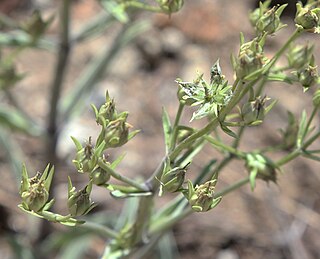
Frasera puberulenta is a species of flowering plant in the gentian family known by the common name Inyo frasera.
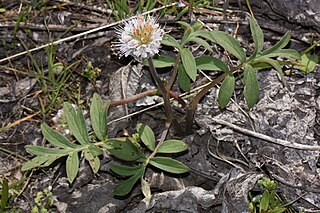
Hydrophyllum capitatum, is a species of waterleaf known by the common name ballhead waterleaf. It is native to Western North America from British Columbia to Utah.
Hydrophyllum brownei, or Browne's waterleaf, is a rare North American plant species found only in the Ouachita Mountains in Arkansas. It grows in forested hillsides above the Cossatot River in Howard County, as well as in Polk and Garland Counties.

Hydrophyllum appendiculatum, commonly known as great waterleaf, appendage waterleaf, or woolen breeches, is a species of plant in the Boraginaceae (borage) family. It is native to central and eastern North America where it is found primarily in the Midwest and Upper South of the United States. It is a biennial that produces lavender-colored flowers in late spring and early summer.
